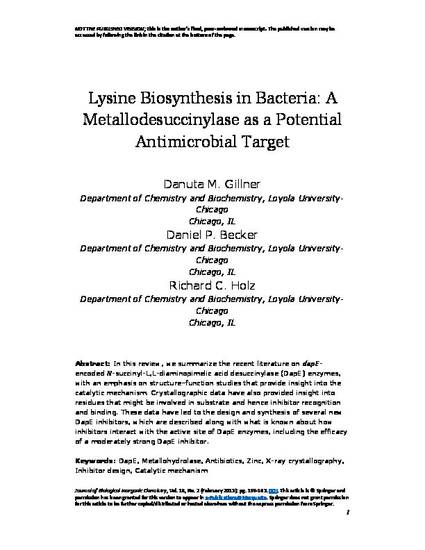
Article
Lysine Biosynthesis in Bacteria: A Metallodesuccinylase as a Potential Antimicrobial Target
Journal of Biological Inorganic Biochemistry
Document Type
Article
Publication Date
2-1-2013
Disciplines
Abstract
In this review, we summarize the recent literature on dapE-encoded N-succinyl-l,l-diaminopimelic acid desuccinylase (DapE) enzymes, with an emphasis on structure–function studies that provide insight into the catalytic mechanism. Crystallographic data have also provided insight into residues that might be involved in substrate and hence inhibitor recognition and binding. These data have led to the design and synthesis of several new DapE inhibitors, which are described along with what is known about how inhibitors interact with the active site of DapE enzymes, including the efficacy of a moderately strong DapE inhibitor.
Citation Information
Danuta Gillner, Daniel P. Becker and Richard C. Holz. "Lysine Biosynthesis in Bacteria: A Metallodesuccinylase as a Potential Antimicrobial Target" Journal of Biological Inorganic Biochemistry (2013) ISSN: 0949-8257 Available at: http://works.bepress.com/richard_holz/5/

Accepted version. Journal of Biological Inorganic Chemistry. Vol. 18, No. 2 (February 2013): 155-163. DOI. © 2013 Springer. Used with permission.
Richard C. Holz was affiliated with Loyola University-Chicago at the time of publication.
Shareable Link. Provided by the Springer Nature SharedIt content-sharing initiative.